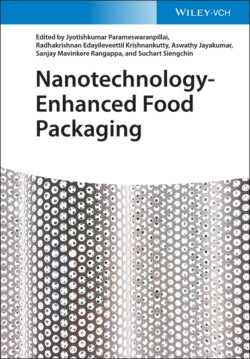Читать книгу Nanotechnology-Enhanced Food Packaging - Группа авторов - Страница 35
2.2 Main Polymers Isolated from Biomass 2.2.1 Casein and Whey
ОглавлениеMilk proteins are conformed by casein and whey; casein is a milk-specific protein (∼80%) having four different proteins (αS1-, αS1-, β-, and κ-caseins). In milk, this protein form colloidal micelles with particle size between 50 and 600 nm. Caseins can be coagulated using acid compounds or enzymes (rennet), given that the coagulation method impacts the physicochemical properties of this macromolecule [12]. Acid casein is obtained after its precipitation by the exposure of the milk below pH 4.6 (isoelectric point of casein). In the enzymatic method, caseins are coagulated using chymosin (rennet) enzymes where several chemical bonds are cleaved in κ-casein. Rennet caseins are insoluble in water, and they have a pH around 7.5 [13].
Acid caseins are also insoluble in water, so they are neutralized to pH 6.7 using potassium, sodium, calcium, or ammonium to obtain caseinates, which are soluble in water. In another way, casein can be neutralized using sodium hydroxide to produce a caseinate called as sodium caseinate. Similarly, sodium, ammonium, and potassium caseinates are obtained using others neutralizing agents. Some caseinates such as sodium, ammonium, and potassium caseinates have similar physical properties, and their solutions are viscous and translucent. In contrast, solutions based on calcium caseinate are turbid [14]. Sodium and calcium caseinates are the most utilized biopolymers due to their excellent solubility, gelation, viscosity, and emulsifying and foaming properties [15].
Casein is a macromolecule having a high degree of polar groups such as carboxyl and amino, which provide good film-forming properties. Furthermore, films based on casein have acceptable gas barrier against the oxygen and other nonpolar molecules, being used as film or coating to reduce the lipid oxidation of foods [16]. In addition, films and coatings based on casein can be used as active material by blending with vitamins, minerals, dyes, and bioactive compounds (e.g. antioxidant and antimicrobial), preserving the food quality, and increasing the food shelf life [17]. Other characteristics in casein such as high nutritional value, water solubility, and emulsification capability turn this macromolecule an important material to manufacture edible packaging [18]. Table 2.1 shows some recent studies that applied casein derivatives as food packaging materials with antimicrobial and antioxidant properties.
Whey is a protein obtained from cheese or coagulated dairy products; this macromolecule is considered as by-product and represents approximately 20% of the total milk protein. Whey has a water content oscillating between 85% and 90% and a solid fraction composed of lactose, proteins, lipids, and minerals [28, 29]. In the food sector, whey can be used in liquid form, as powdered cheese whey, as lactose, and as proteins isolate or concentrate [30]. The proteins from whey are separated (concentration) and applied in the food industry due to their excellent nutritional and functional properties. Whey protein concentrate (WPC) and whey protein isolate (WPI) are obtained from the removal of nonprotein fractions to attain a protein content higher than 25% and 90%, in the final product, respectively [28].
Table 2.1 Films and coatings based on casein and whey for food packaging applications.
| Components | Production approach | Main results | References |
|---|---|---|---|
| CASa)/tannin from white peel grape, red peel grape, and oak bark | Casting | Films with improved water solubility and water vapor permeability. Bilayer films containing tannin have antioxidant property and antimicrobial activity against E. Coli and L. innocua | [19] |
| CASa)/LMPb)/glycerol/natamycin | Casting | Films with antimicrobial activity against P. chrysogenum inoculated on cured meat | [20] |
| CASa)/arabic gum/essential oil from cinnamon and lemon | Dip coating | Films with antioxidant activity were used to extend the shelf life of guava up to 40 days | [21] |
| WPCc)/glycerol/rosemary extract | Casting | The films delayed the salami's lipid oxidation for 30 days | [22] |
| WPCc)/glycerol/extracts from Shirazi thyme, sage leaves, and cumin seeds | Coating | The coating inhibited the A. flavus growth in pistachio kernels contaminated | [23] |
| Whey protein/glycerol/green tea active extract | Casting | The films delayed the lipid oxidation of fresh salmon samples until the 14th day of storage | [24] |
| WPId)/pectin/alginate/glycerol/tween 20 | Casting | Coatings were efficient to retain the humidity of bread | [25] |
| e) WPNF/glycerol/trehalose | Casting | Coatings with hydrophobic surface and antioxidant activities | [26] |
| WPId)/PLAf) resin/glycerol | Extrusion | Films reduced the lipid oxidation in baby foods | [27] |
a) CAS: sodium caseinate.
b) LMP: low methoxyl pectin.
c) WPC: whey protein concentrate.
d) WPI: whey protein isolate.
e) WPNF: whey protein nanofibrils.
f) PLA: poly(lactic acid).
Whey proteins are composed of different globular proteins such as β-lactoglobulin, α-lactalbumin, bovine serum albumin, immunoglobulins, and the polypeptides proteose-peptone. Particularly, β-lactoglobulin is the major whey protein responsible for gelation and aggregation behavior in whey [31].
Films and coatings based on whey are transparent materials, and they have better mechanical and barrier properties when compared with those manufactured with polysaccharides. Protein network in whey can be modified by means of thermal treatments, and the resulting modified whey can be used to manufacture materials with improved tensile and barrier properties [29, 31].
Finally, films and coatings based on casein and whey have limited elasticity and water sensitivity, limiting their applications. The films elasticity can be improved using plasticizers such as glycerol or sorbitol into the film-forming solution [18, 29]. Table 2.1 shows some studies using WPC and WPI with addition of plasticizers for antimicrobial and antioxidant food packaging.
